
‘Afraid of the water’? Life in a city that dumps billions of litres of raw sewage into lakes and rivers
10 billion litres of sewage are dumped into Winnipeg’s lakes and rivers each year. Some...
On a foggy June morning, Jeff Jones loads four workers wearing hip waders and five bouncy dogs into his boat at a landing in the Pacheedaht First Nation community. Jones, the Pacheedaht Chief, is as comfortable on the water as he is on land; growing up in the windswept maritime community, he fished with his father for halibut, rockfish, ling cod, salmon, “whatever bites.” As a young man, Jones moved to Victoria. But his roots tugged him back to Pacheedaht territory on southwest Vancouver Island, where he took a job as a fisheries guardian, becoming a federally certified Aboriginal Fisheries Officer. “I love the people, I love my family,” says the Chief, who has a son and daughter in their early 20s.
Along with hip waders, knee pads and gaiters, Jones wears a sleek, long-sleeved grey shirt and a baseball cap emblazoned with the Pacheedaht First Nation logo. The logo depicts a whaler and a whaling canoe. A harpoon enters one end of the logo circle and exits the other, after passing through a humpback whale. A long strand of bull kelp, traditionally used as rope, wraps around the circle, tied to the harpoon. The days when the Pacheedaht hunted humpback and gray whales, which had tasty, preferred meat and oil rich blubber, are over, at least for now. But the Pacheedaht, whose name means “people of the sea foam” in their Nitinaht language, will always be a nation moored to the sea.

Jones steers the aluminum skiff up the Gordon River, into Brown’s slough in the estuary. The water is gray-green and barely ripples. An artificial island and historic salt grass marsh rise from the water like a little hat, covered in vegetation and spruce trees. There’s no hint that eight decades ago the estuary was home to a massive log sort yard — the province’s largest — until you look at the LIDAR maps the Chief’s wife, Helen Jones, the Pacheedaht fisheries manager, shows us on a tablet. The maps reveal where the land and water used to be before extensive dredging took place and dikes were constructed to facilitate the water transport of red and yellow cedar, Douglas fir and hemlock trees hauled from nearby valleys. Dredging for historic logging operations destroyed salt grass marshes that nurtured juvenile salmon, contributing to the decline of a primary food source for the Pacheedaht. Now the nation aims to rebuild populations of all five salmon species, starting in the delta where the San Juan and Gordon Rivers wend from east and north to merge in the sheltered waters of the Pacific.
The fog is slowly lifting. An eye of blue sky winks at us, and the breeze ruffles our hair.
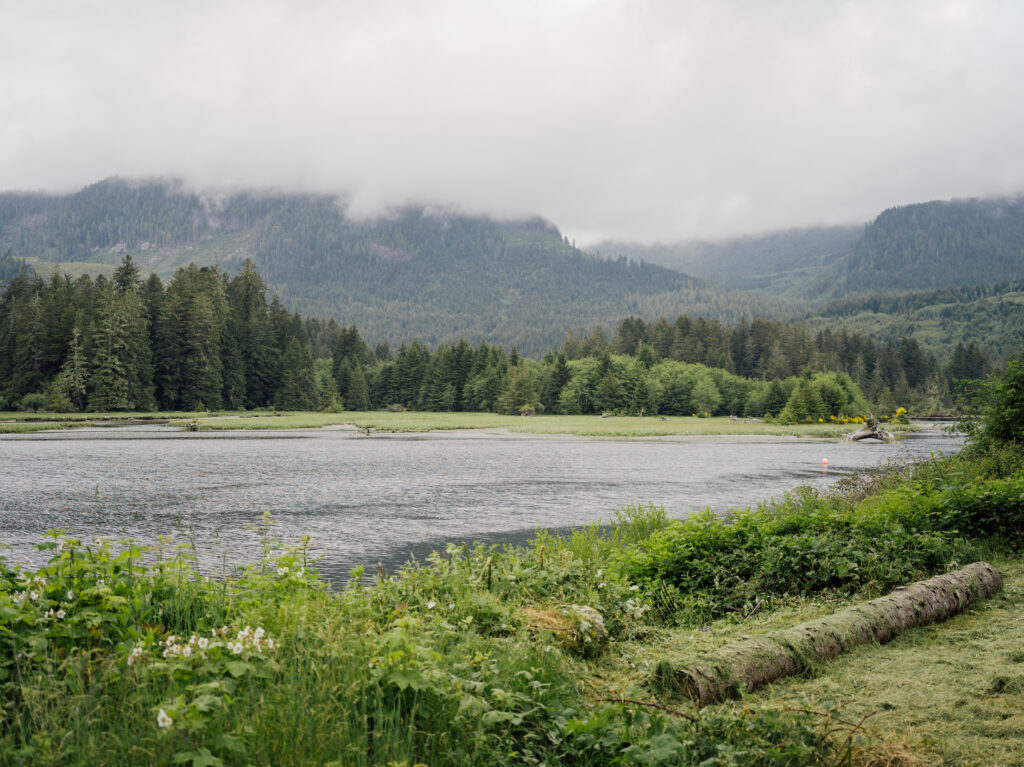

We scramble onto the boggy shore of an island where four Pacheedaht members in hip waders are planting sedges and grasses to repair damage to fish habitat caused by decades of industrial logging — logging in which the nation played no part and from which it received no benefit. An eagle lets out a high-pitched whistle. Our boots squelch in the mud. Then, slicing through the stillness, comes the throaty chuckachuka-chuckachuka of a RCMP helicopter.
For the Chief, “everything that’s been happening,” refers to the blockades taking place in and around the Fairy Creek watershed on Pacheedaht territory and in the neighbouring territory of the Ditidaht First Nation. From the estuary, we can almost see the green spirals of the Fairy Creek valley, only a few kilometres distant, that has become the epicentre of a flourishing movement to save the last of B.C.’s unprotected old-growth forests. At this very moment, RCMP are arresting protesters wedged into tall tripods hammered together with discarded logs or lying under tarps with their arms chained inside “sleeping dragons” — metal tubes dug into the ground. When the RCMP leave each day, more protesters (or land defenders, tree protectors, tree-huggers or intruders, depending on whom you talk to) drive their cars, camper vans, trucks and SUVs up the inclines of logging roads that provide access to planned logging in the Fairy Creek watershed.
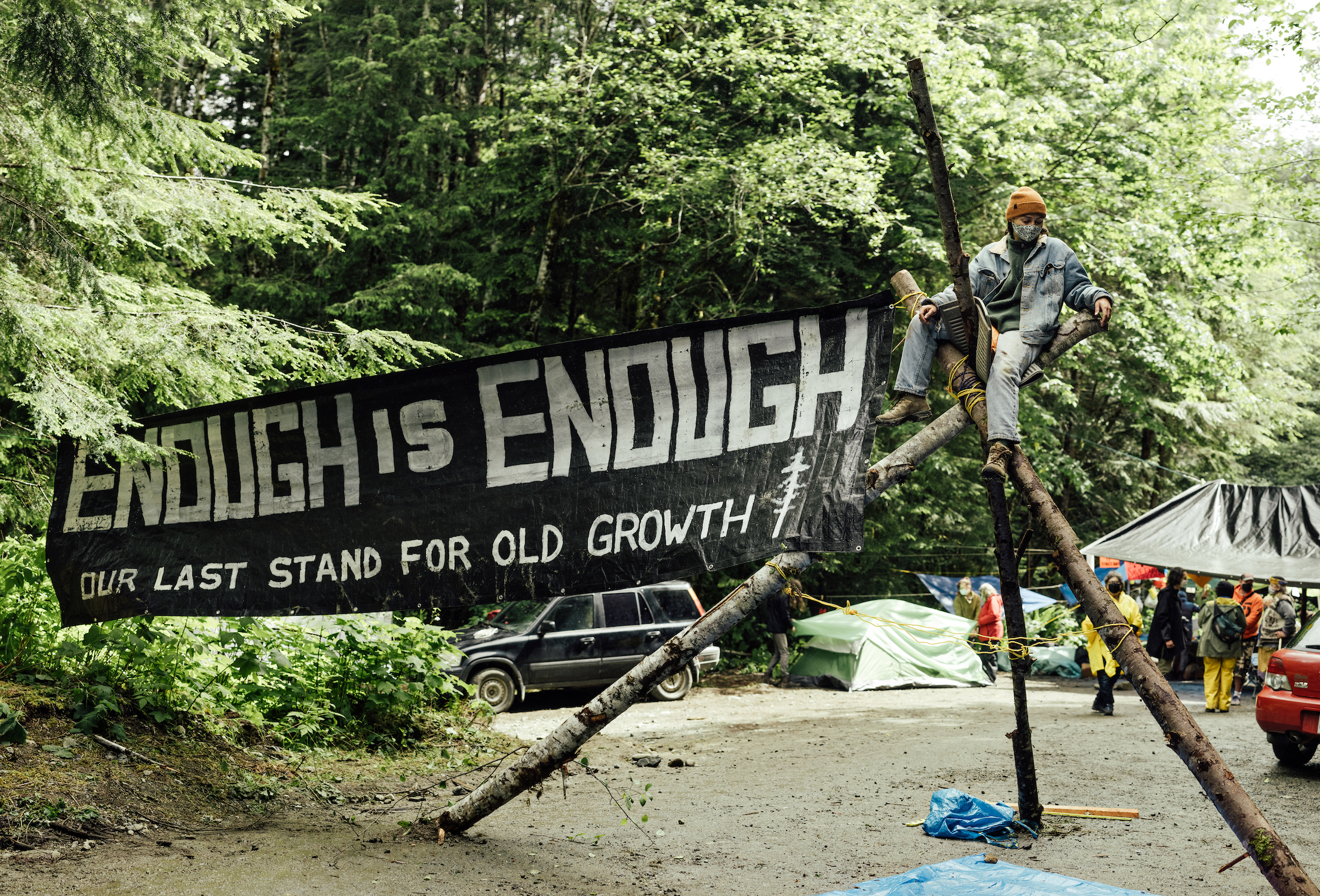


Led by the Rainforest Flying Squad, a volunteer-driven, grassroots organization whose Fairy Creek blockade Instagram account has a following of more than 61,000, they have set up tents, teepees and open-air communal kitchens with tin roofs. Hanging on hooks are enough chains, kryptonite locks and padlocks to make Houdini smile. Logging roads are studded with barricades: cars ready to be pushed across the road to block access when the RCMP arrive, crates weighted down with stones, heaps of rocks in little pyramids stretching hundreds of metres, ramparts of weathered logs hauled up from clear cuts.
The RCMP are on the scene because forestry company Teal-Jones was granted a court injunction in mid-April to remove protesters blocking access to the company’s approved logging cut block in Fairy Creek, the last unprotected, relatively intact watershed on southwest Vancouver Island. More than 300 people have since been arrested, making Fairy Creek one of the largest civil disobedience actions in recent Canadian history. Weekend rallies have drawn hundreds of people. Parents pull their preschoolers along logging roads in wagons. Hikers pack in tents and food. It’s only a two-hour drive from the province’s capital city of Victoria; you can throw together a picnic, toss some drinks in the cooler, tie up your walking shoes and go for the day.
At the logging road entrance to the Fairy Creek blockade headquarters, a white sign on the ground, anchored by stones, says, in hand painted black letters, “We expect visitors to recognize and affirm the rights and title of Pacheedaht First Nation.”

There’s just one problem, and it’s creating what Jones calls a “very uncomfortable” situation. The Pacheedaht First Nation’s elected leadership — and Frank Queesto Jones, the Hereditary Chief recognized by the Nation — have asked, several times, for the protesters to leave, saying the nation does not welcome or support unsolicited involvement or interference by others. On June 28, as a heat dome settled over the Pacific Northwest and temperatures near Fairy Creek soared to 40 degrees Celsius, the Nation again called on protesters to leave, citing the increased risk of human-caused wildfire that could threaten the Pacheedaht First Nation community. The neighbouring Ditidaht and Huu-ay-aht First Nations which, together with the Pacheedaht, form the most southern branch of the Nuu-chah-nulth people, support the Pacheedaht. They, too, have requested that anyone interfering with legally authorized forestry operations leave their territories.
“For years we’ve been subject to colonial policy,” Huu-ay-aht Chief Robert Dennis tells The Narwhal. “Some outside force — mainly the federal government — comes onto our land and says ‘we’re going to take care of you and we’re going to do things better than you’ve been doing.’ ”
“Now I’m seeing some outside force saying, ‘oh you know what, we want to halt old-growth logging. And when we do that we want to halt the First Nations’ rights to harvest cedar for cultural purposes … we want to infringe on their Treaty Rights … I’m seeing systemic racism continuing. ‘You Indians don’t have the ability to carry yourselves, so we’re going to fight for you and we’re going to protect the old- growth whether you like it or not.’ That’s what they’re doing, that’s what they’re saying.”
In early June, with tensions mounting in the midst of RCMP enforcement activities, the Pacheedaht First Nation asked the B.C. government for a two-year deferral — readily granted — on old-growth logging in 2,000 hectares of the Fairy Creek watershed and the nearby Central Walbran, including in an area known to the public as Castle Grove. Pacheedaht forestry manager Rod Bealing says the deferral will allow the nation time to complete its integrated resource stewardship plan, which will include community meetings to discuss the future of old-growth logging in Pacheedaht territory. “They’ve got to have a proper process.”
“It will be the people of Pacheedaht that will be deciding how much old-growth to save, how much old-growth to log,” Chief Jones says. “I think really getting down to the core number of how much old-growth is left is a really good place to start.” Included in Pacheedaht territory, he notes, are old-growth watersheds in Pacific Rim National Park and Carmanah Walbran Provincial Park, old-growth management areas designated by the provincial government and old-growth cedar areas set aside by the Nation for cultural purposes.
All three nations are developing integrated resource management plans for their territories in a process that will draw on the “teachings of ancestors,” the “wisdom of Elders,” input from citizens and partners and “the best forestry, fishery and integrated resource management advice available.” The Pacheedaht plan will include identification of special sites, traditional use areas and places where conservation measures will be instituted. “Pacheedaht needs to be left in peace to engage in our community-led stewardship planning process so that we can determine our own way forward as a strong and independent Nation,” Chief Jones and Hereditary Chief Frank Queesto Jones have stated.
Pacheedaht Elder Bill Jones has a different point of view that has garnered extensive national and international media coverage. He has welcomed the protesters to Fairy Creek, urging people to continue to take direct action to stop all old-growth logging in his nation’s territory. “I implore people to continue to stand with me to protect our forests from destruction and colonialism because we need allies on the ground to stop old-growth logging in my home territory, and for my future generations and relatives,” Jones says in an interview with his niece, Kati George-Jim, who is from the T’Sou-ke First Nation and supports the blockades.
Bill Jones has also publicly questioned Frank Queesto Jones’ position as Hereditary Chief, instead supporting Victor Peter, a teenage Pacheedaht member who says in a Facebook video that he is the upcoming hereditary chief and will take up the mantle for the first time at the Fairy Creek blockades. The protesters and some environmental groups supporting the blockades call Peter the Pacheedaht hereditary chief, even though such decisions rest with Indigenous communities and Peter has not yet been through a traditional process to determine whether or not he is ready to assume those responsibilities. The interview with Bill Jones is posted on the Flying Rainforest Squad website, along with the message: “Are you ready to join us to protect the remaining fragments of ancient forests on Pacheedaht Territory?”
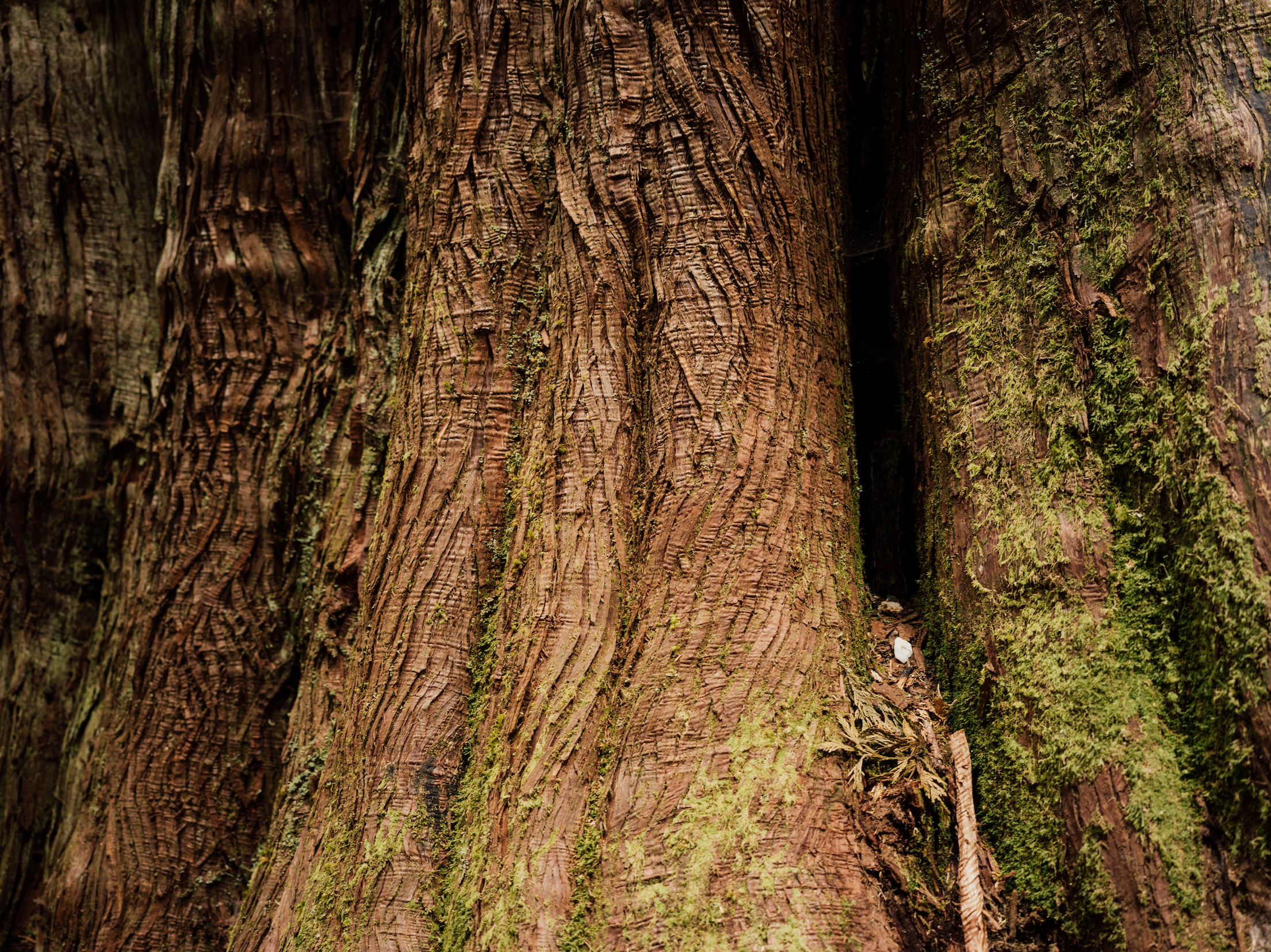
Unprotected old-growth forests are at-risk all over B.C. Less than three per cent of the province’s biggest, most ecologically important old-growth remains, according to a report from a trio of independent scientists who used to work for the B.C. government. In the interior, the rare inland temperate rainforest, home to endangered caribou and cedar trees more than 1,000 years old, is at imminent risk of clear-cutting in places like the Anzac Valley. Earlier this year, a Prince George-based forestry company applied for an exploratory permit to build a logging road through a provincial protected area in the intact Raush River Valley near McBride to access rare old-growth stands.
First Nations across B.C. are involved in the forestry industry, which provides revenue and jobs. Yet Pacheedaht First Nation has been catapulted into the national spotlight, caught in the crossfire of B.C.’s new “war in the woods,” waged by environmental groups and individuals who underscore that ancient forests can never be replaced, pointing to the essential role of old forests in storing carbon and protecting nature in an era of accelerating climate change and biodiversity loss. “I think we can probably all sympathize with the complex situation that the Pacheedaht Nation is facing,” says Andrea Innes, a campaigner for the Ancient Forest Alliance, which works to protect old-growth but does not support unlawful activities.
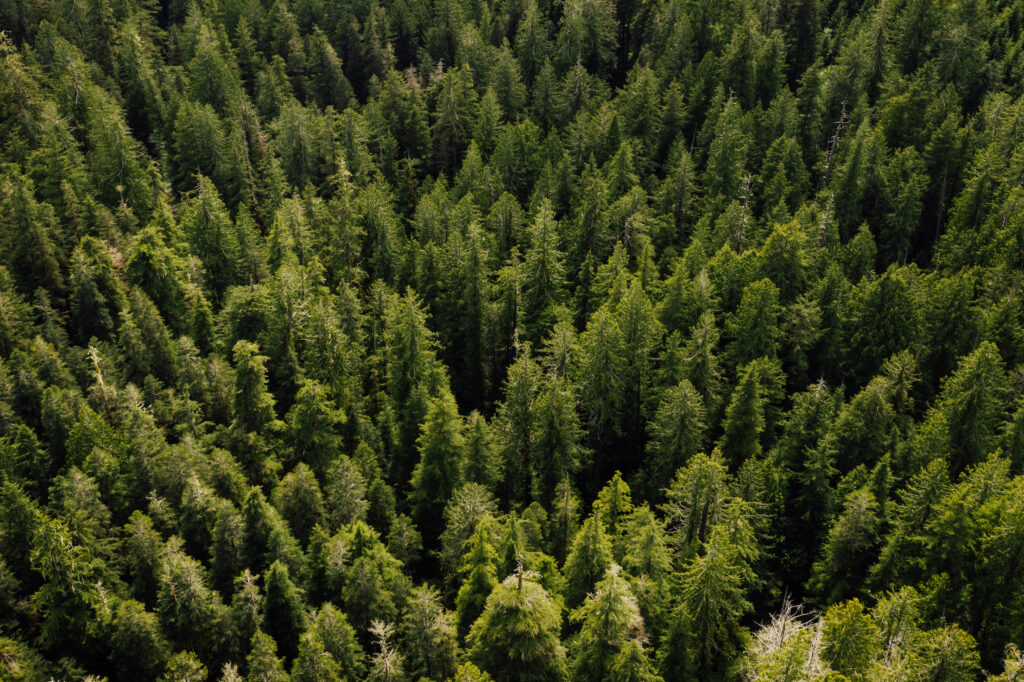
Irregular pieces of brown flank the watershed, denoting fresh cut blocks in adjoining valleys. About 100 hectares of the southernmost section of the Fairy Creek valley, much of it logged in the 1970s by British Columbia Forest Products, is lighter green. It’s not far from Fairy Lake, which has a much-photographed tree growing out of a log in the lake, like a giant bonsai. Along the north end of Fairy Lake, off Pacific Marine Road, is a forest recreation campsite studded with old-growth Douglas firs.
Cross the road and you’ll find the Fairy Creek mainline, an overgrown logging road that branches off to an 80-hectare area just outside the watershed that is off limits to logging; it’s designated ungulate winter range for reintroduced Roosevelt elk that the Pacheedaht Nation hopes to be able to hunt again one day. Some refer to Fairy Creek as pristine, dismissing the Pacheedaht who have occupied the land for millennia, felling old-growth cedar for canoes and dwellings, stripping cedar bark for clothing, baskets, nets and fishing lines, hunting elk, bear and deer and gathering medicines and berries from ancient forests streaked by wide beams of slanted sunlight or misted with rain.
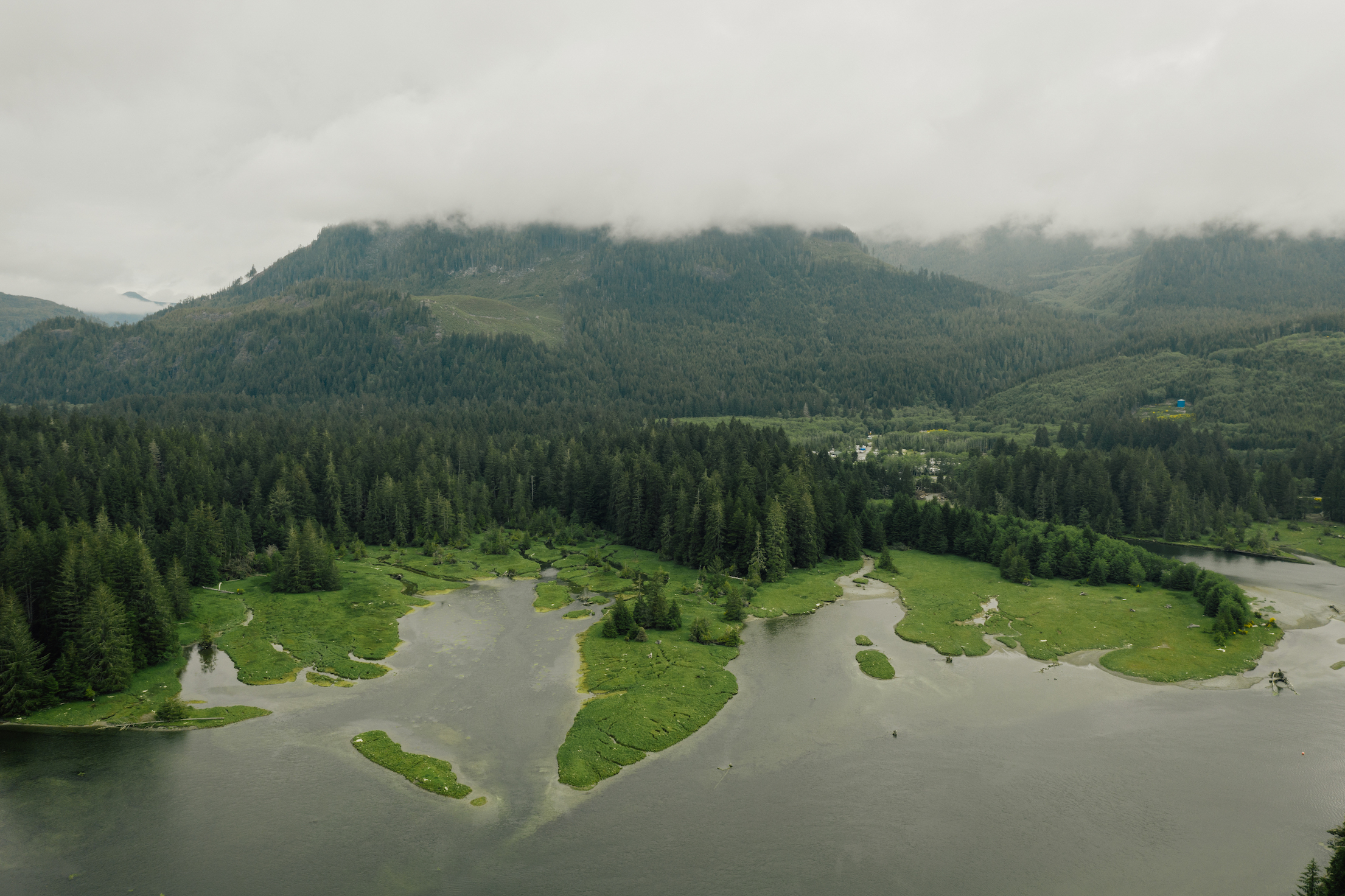
A sizable chunk of the Fairy Creek watershed was already off-limits to most timber harvesting because it is a provincially designated old-growth management area and wildlife management area for the marbled murrelet, a small brown seabird that nests in old-growth forests near the ocean. The B.C. government says the two-year deferral increases the area of protected old forest in the Fairy Creek watershed to 884 hectares. Only some of the second-growth forest can still be harvested over the next two years.
Last August, Teal Jones began to extend an existing road along the ridgeline above the Fairy Creek watershed, in anticipation of logging a proposed 21-hectare old-growth cutblock. Thirteen hectares of the proposed cutblock are within the Fairy Creek watershed, according to the company. According to the Ancient Forest Alliance, the proposed cutblock contains massive yellow cedar trees, including one measuring more than three metres in diameter, thought to be close to 2,000 years old. When the news got out, members of the newly formed Rainforest Flying Squad moved in with tents and set up the first blockade to prevent road construction, setting the stage for this year’s mass protests and arrests.
Despite the Fairy Creek logging deferral announcement, the squad has refused to budge, pointing to other old-growth forests slated for logging on Pacheedaht territory in areas surrounding the Fairy Creek watershed, including on Edinburgh Mountain to the west of Fairy Creek, and in the Caycuse Valley in Ditidaht territory to the north, as well as in the Walbran, further west. One recent statement from some protesters goes so far as to claim the authority of Chief Jones does not apply to the nation’s territory around Fairy Creek, telling him “you are not welcome to visit this land.”
Chief Dennis, of the Huu-ay-aht First Nations, says social media attacks on the Pacheedaht’s soft-spoken Chief, whom he calls “an incredible man,” are astounding. “Chief Jones is a very respectful man and a very caring man. He wants to take care of his people. He wants to do things so that people have a job, because if you don’t have a job you can’t provide for your family … They don’t have any respect for Chief Jones at all. It’s the opposite of respect. It’s the worst I’ve ever seen. To humiliate this man and come onto his land …? I’m at a loss for words.”
Jones, who was re-elected last year, is serving his second consecutive term as Chief. He was also the Chief for a two-year term in the early 2000s. “I was too young,” he says of his first stint in office. “We had two young children and I didn’t run again. I took about 12 years out, until our children graduated, and then jumped back into the ring.” With equanimity, the Chief says that Bill Jones is entitled to his opinion but that he does not speak for the nation. “Bill Jones is only speaking on his own behalf as a Pacheedaht Elder.”
The Pacheedaht Nation has close to 300 members. About 120 live in the Pacheedaht community, less than a 15-minute drive from the blockades. And the inconvenient truth for the protesters, however well-intentioned in their inventive and prolonged efforts to save old-growth, however well-versed in the parlance of acknowledging the territories of Indigenous peoples, is that only a few Pacheedaht members have joined them.
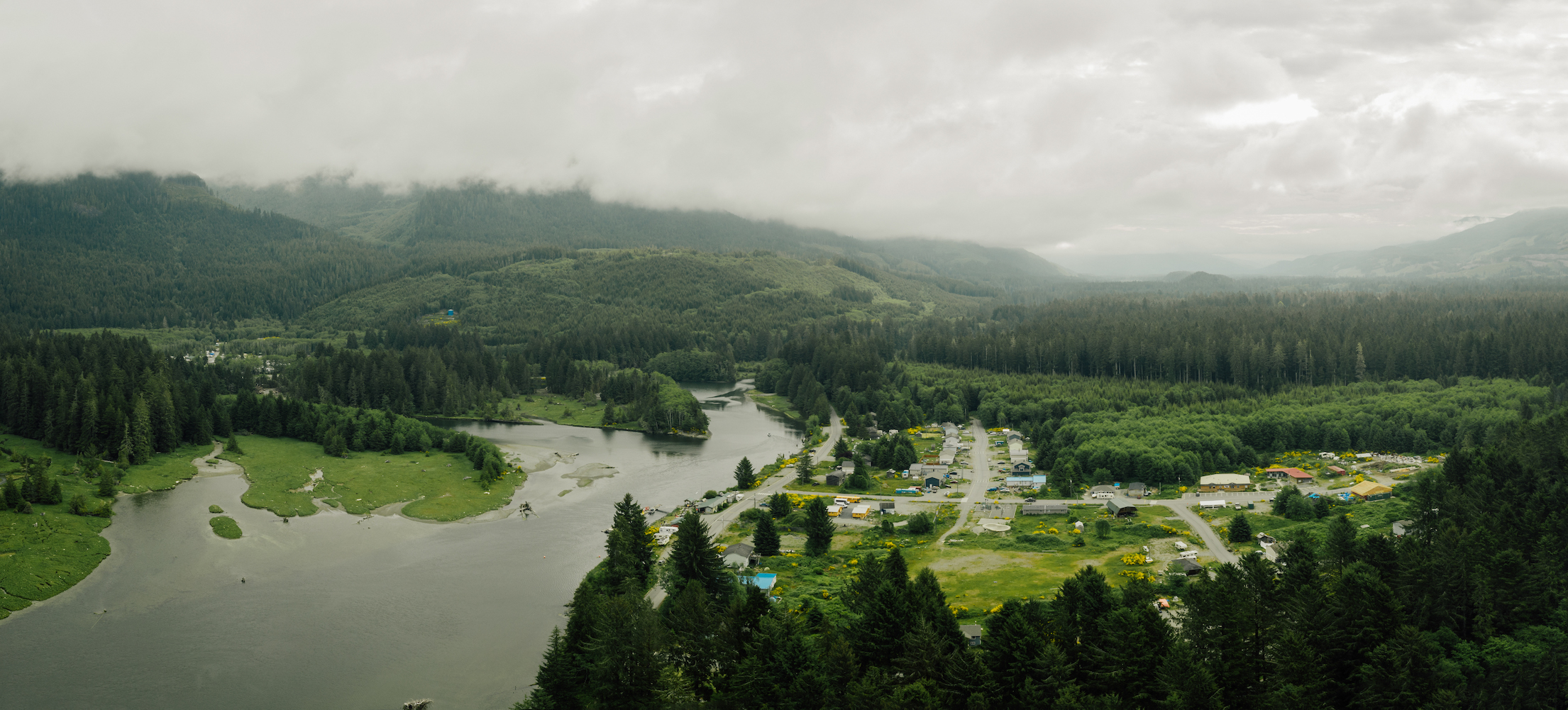
A weathered Pacheedaht long house peeks out from the bank across the estuary, where the log sort was located many decades ago. The long house is accessed by a short bridge resting on concrete blocks so new they are still shiny and white. Last year, the nation pulled out two culverts left over from logging. Pacheedaht members graded the inlet and planted sedges in the channel behind the new bridge to relink the estuary to an historic salt marsh, restoring connections to salmon rearing habitat. As part of the restoration project, funded by Fisheries and Oceans Canada, the nation also bulldozed a six-metre high berm on the artificial island, built for the transfer of logs. Two pre-existing channels were re-dug to connect the estuary to a salt marsh on the north arm of the San Juan River, opening the way for salmon.
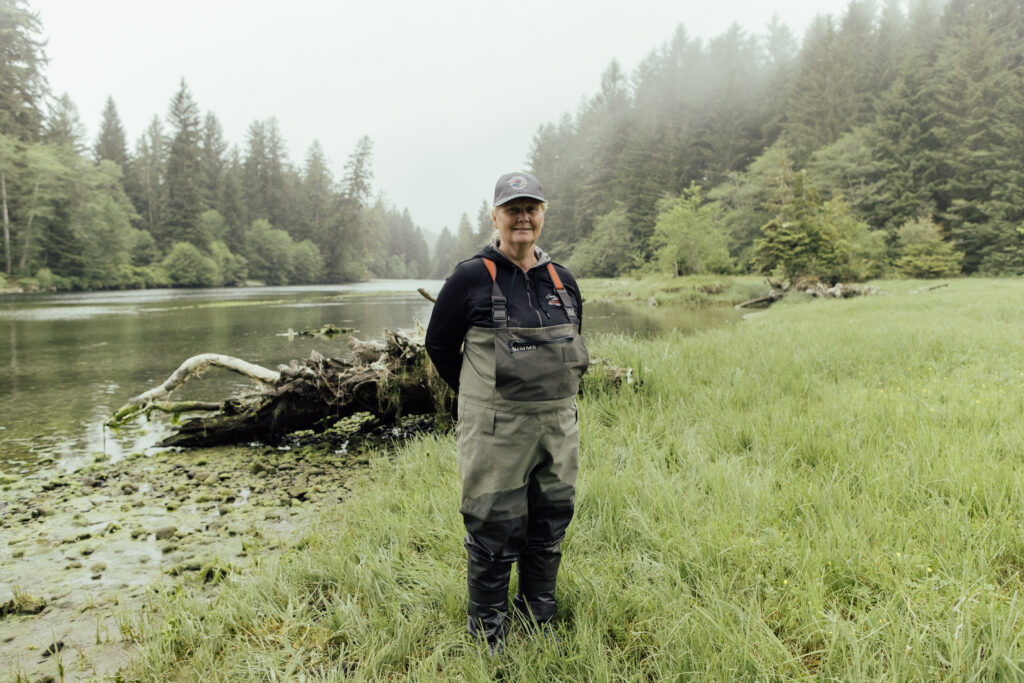
Logging and dredging also destroyed eelgrass beds in the San Juan and Gordon River estuaries; Pacheedaht divers will soon transplant the underwater grass, a natural carbon sink that provides food, nutrients and shelter for juvenile salmon, from other areas in the delta.
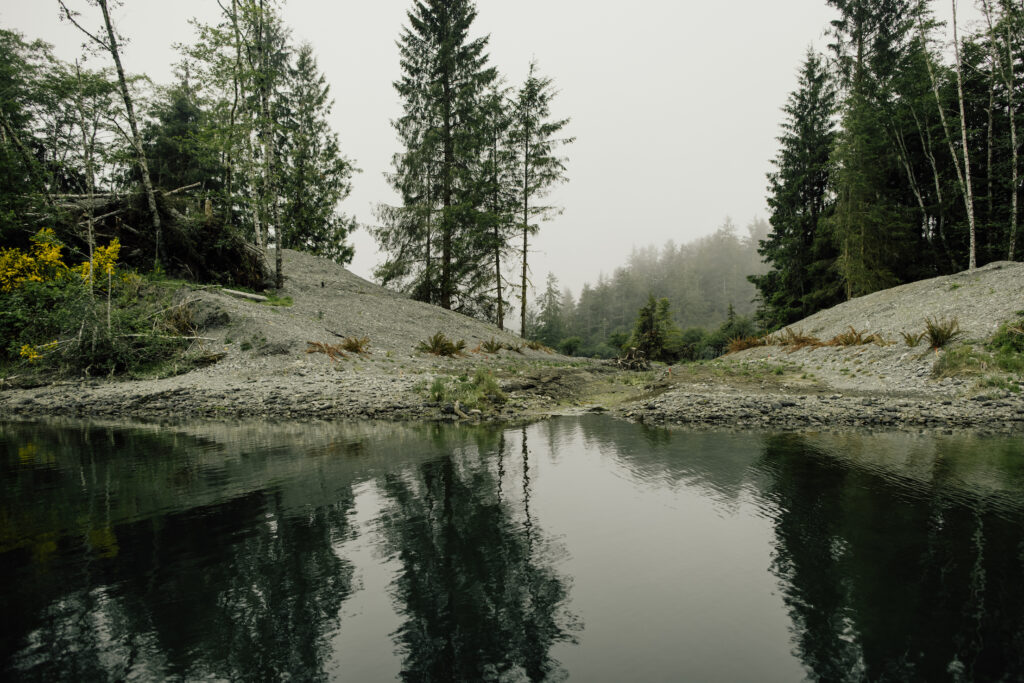
Under the tutelage of restoration ecologist Tanis Gower, Pacheedaht members remove sedges and grasses from one area and wheelbarrow them to a muddy, gravelly depression in the middle of the island.
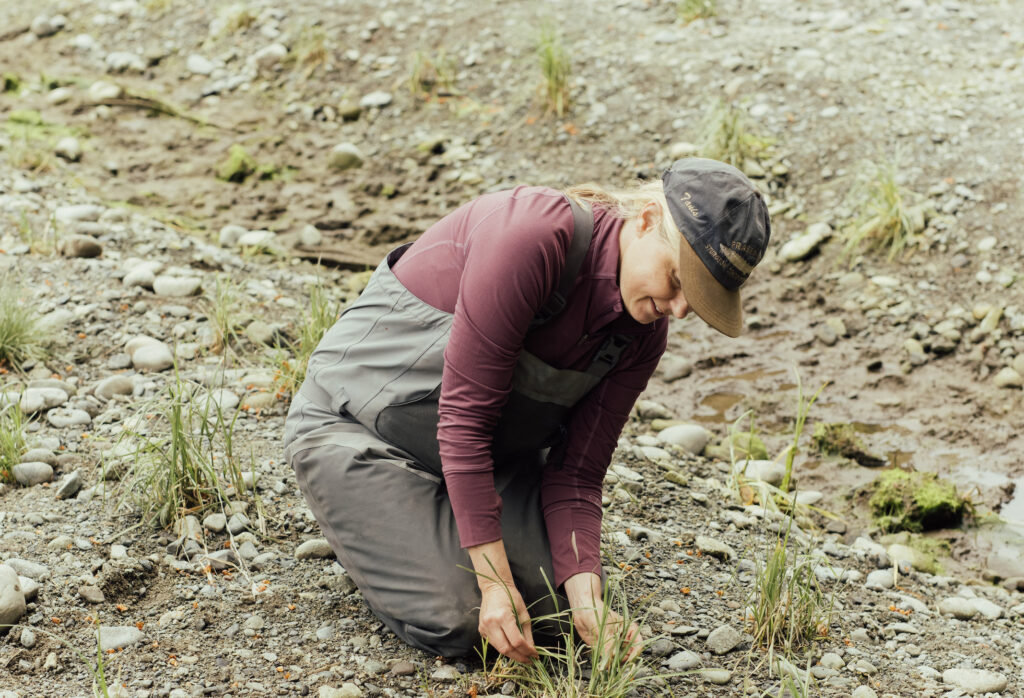
They dig a hole, scatter in fertilizer, nestle in clumps of sedges and grass and pat down the earth.
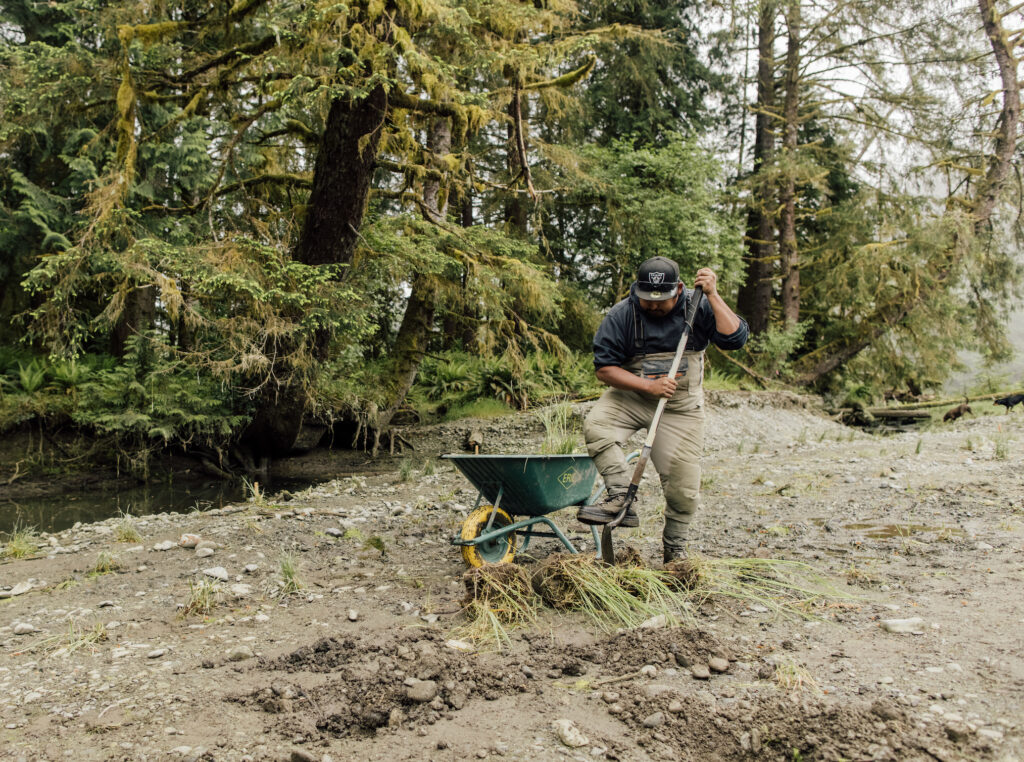
Dig, scatter, nestle, pat. Repeat.
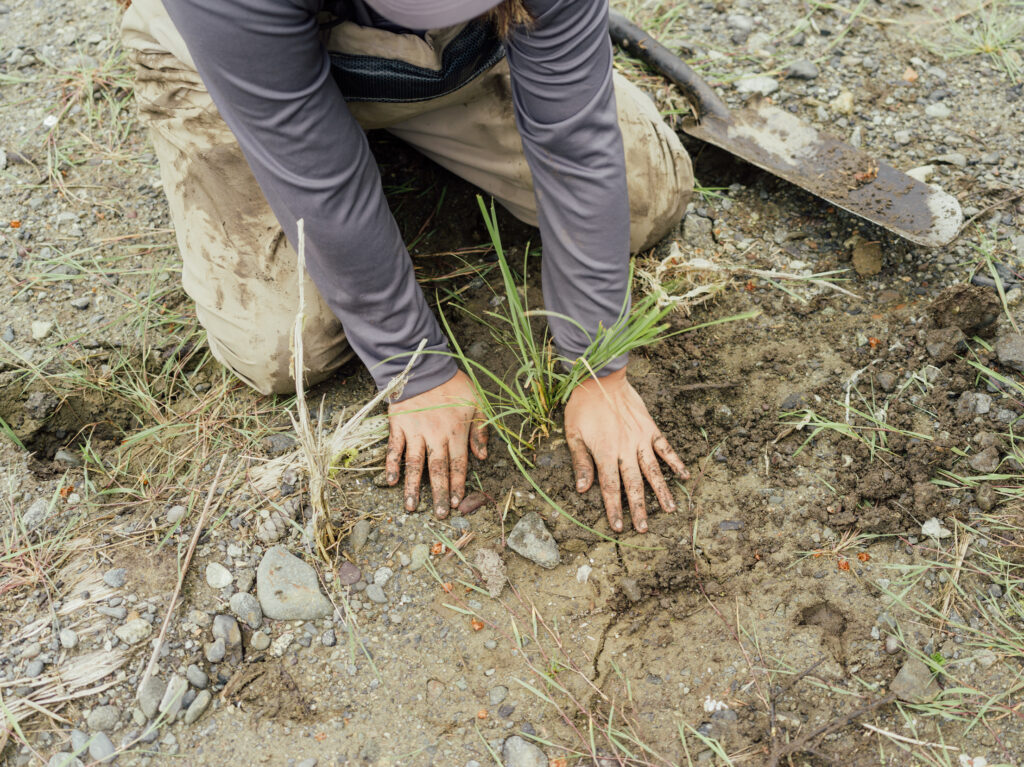
High tide brings the sea and, with it, juvenile salmon who feed on terrestrial insects trapped on the grasses.
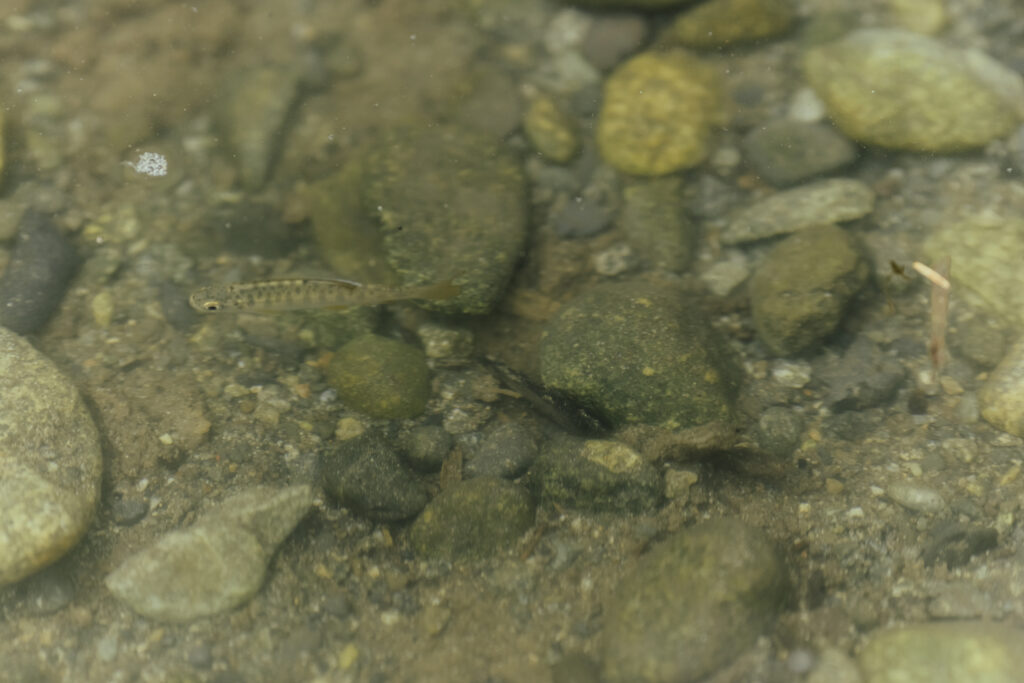
At lunch time, the workers tip wheelbarrows on their sides and sit in them like chairs.
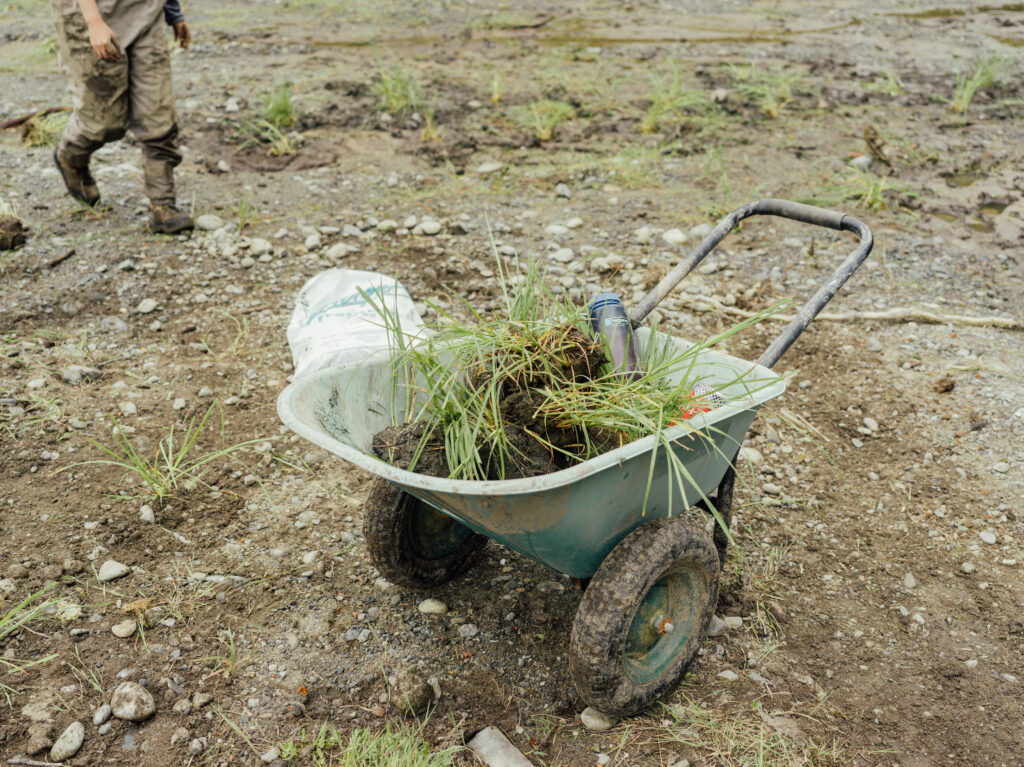
The project is already reaping natural dividends. In a murky channel, dozens of salmon fry, six centimetres long, dart back and forth, moving faster than the eye can follow. “The fish have moved in already,” the Chief says. “Mainly small, juvenile coho. It’s fantastic, it’s really good to see that.” He says the nation is looking forward, not backwards, focusing not on the damage caused by historic logging but on the successful repair work underway. “Overall, we’re just happy to have the opportunity to employ Pacheedaht members in projects like this. It’s a whole new learning process for everyone that’s part of the project. We just carry on.”


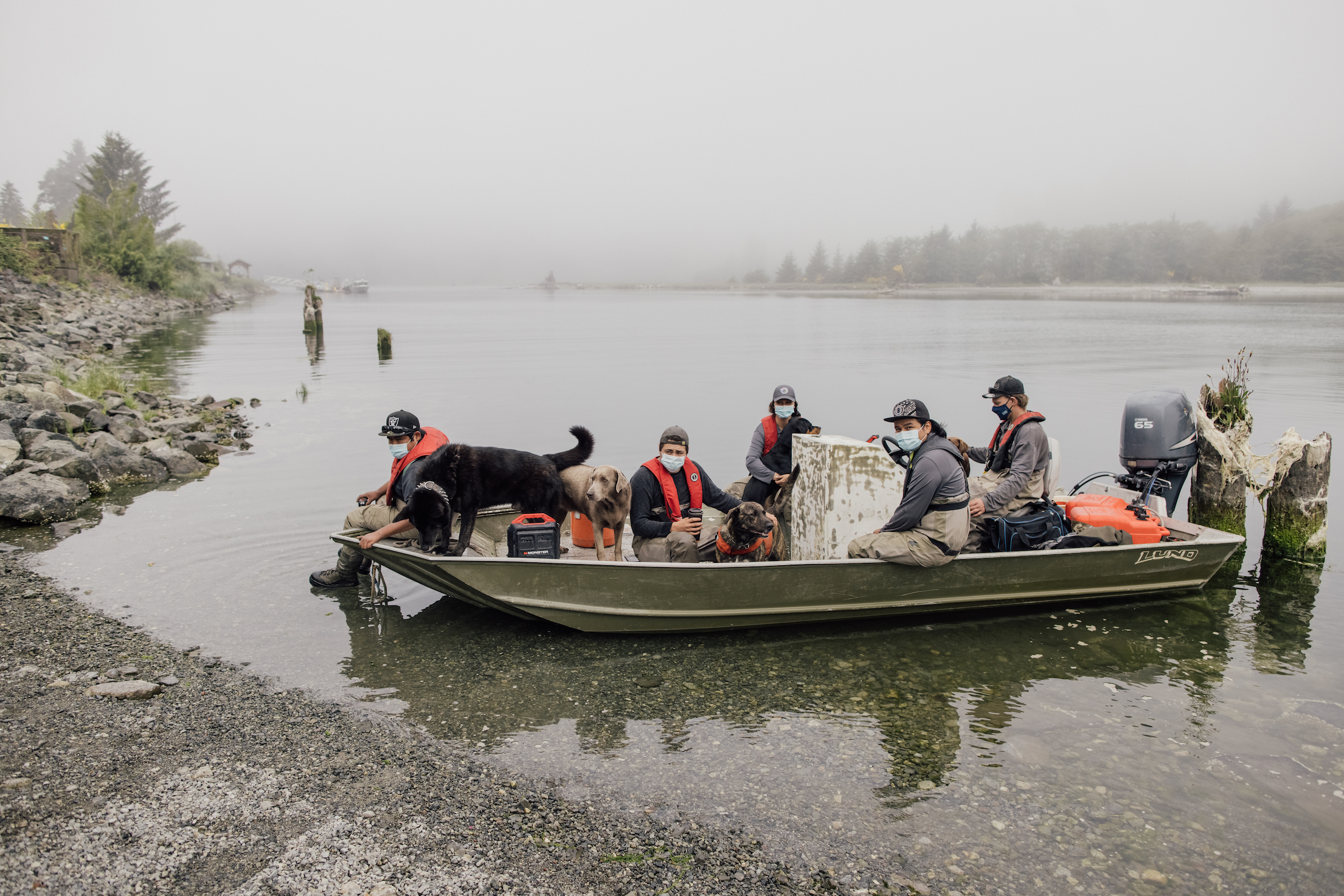
As salmon stocks slowly rebound, the Pacheedaht First Nation continues to assert the right to determine what happens on its territory. The territory stretches from east of Jordan River — an area known as diitiida to the Pachedaht, meaning the place of origin, that is the site of historic logging operations, a BC Hydro dam and a polluting copper mine — to Bonilla Point, and from the mouth of the San Juan River approximately 40 kilometres inland. It also encompasses traditional fishing grounds at the mouth of the Juan de Fuca strait, including an area known as Swiftsure Bank.
Industrial logging took place in Pacheedaht territory for many decades before the Nation accrued any benefits, the Chief points out. “You just take a look around us and you see nothing but forestry resources,” he says. “That tells me something. Why are the logging trucks going by our community and not stopping? Why aren’t we benefitting from the resources that go out of our territory? For the last decade or so we’ve been slowly turning it around.”
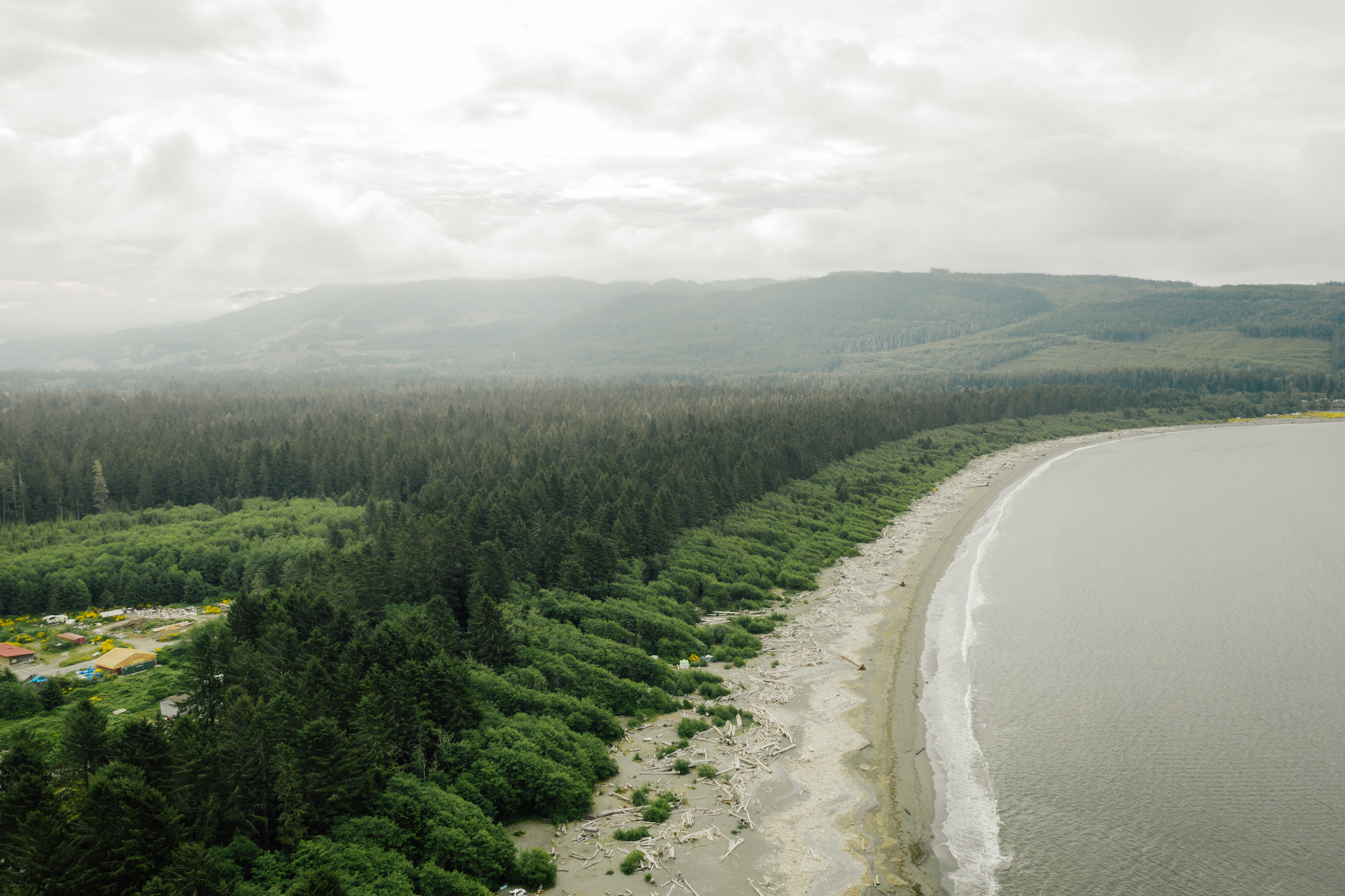
Thirteen years ago, the forested area on the nation’s territory — about 163,000 hectares — was allocated to third parties through licence areas and forest tenures. The Pacheedaht didn’t hold any of the logging rights. Today, the nation manages or co-manages about 140,000 cubic metres of annual cut on its territory — enough trees to fill 3,500 standard-sized logging trucks.
“We’ve been pushed out of the forestry industry for hundreds of years,” the Chief says. “And now we’re at a point where we’re actually benefiting from forestry resources in the territory.”
The nation’s involvement in the forestry industry has been incremental. In 2010, as part of a province-wide effort to include First Nations in the forestry sector, the B.C. government awarded the Pacheedaht First Nation forestry rights to an annual cut of 1,500 cubic metres near the reserve, known as Woodlot Licence 1957 — timber to fill 37 standard-sized logging trucks.
Then the nation entered into a 50-50 partnership with Andersen Timber, a Vancouver-based family business, to purchase about 20,000 hectares — the equivalent size of Salt Spring Island — of a tree farm licence near Jordan River. The newly minted duo formed one company that owns the tenure, now called TFL 61, and another to manage it. With a steady source of income from forestry, the nation deepened its investments in the sector.
Today, the nation co-owns and operates a small dry land sorting facility that scales, grades, sorts and distributes logs, mainly for domestic processing, from the tree farm licence. About four years ago, the Pacheedaht made another forestry investment, buying a small sawmill and setting it up on land it leases not far from the reserve. Together the log sort and the sawmill, which mainly processes cedar, provide about 20 jobs for band members and local residents. “We’re so removed from the big city of Victoria,” the Chief says. “You can’t just jump up and go to a job in Duncan. Providing these long-term stable jobs really helps the individual and their family.”
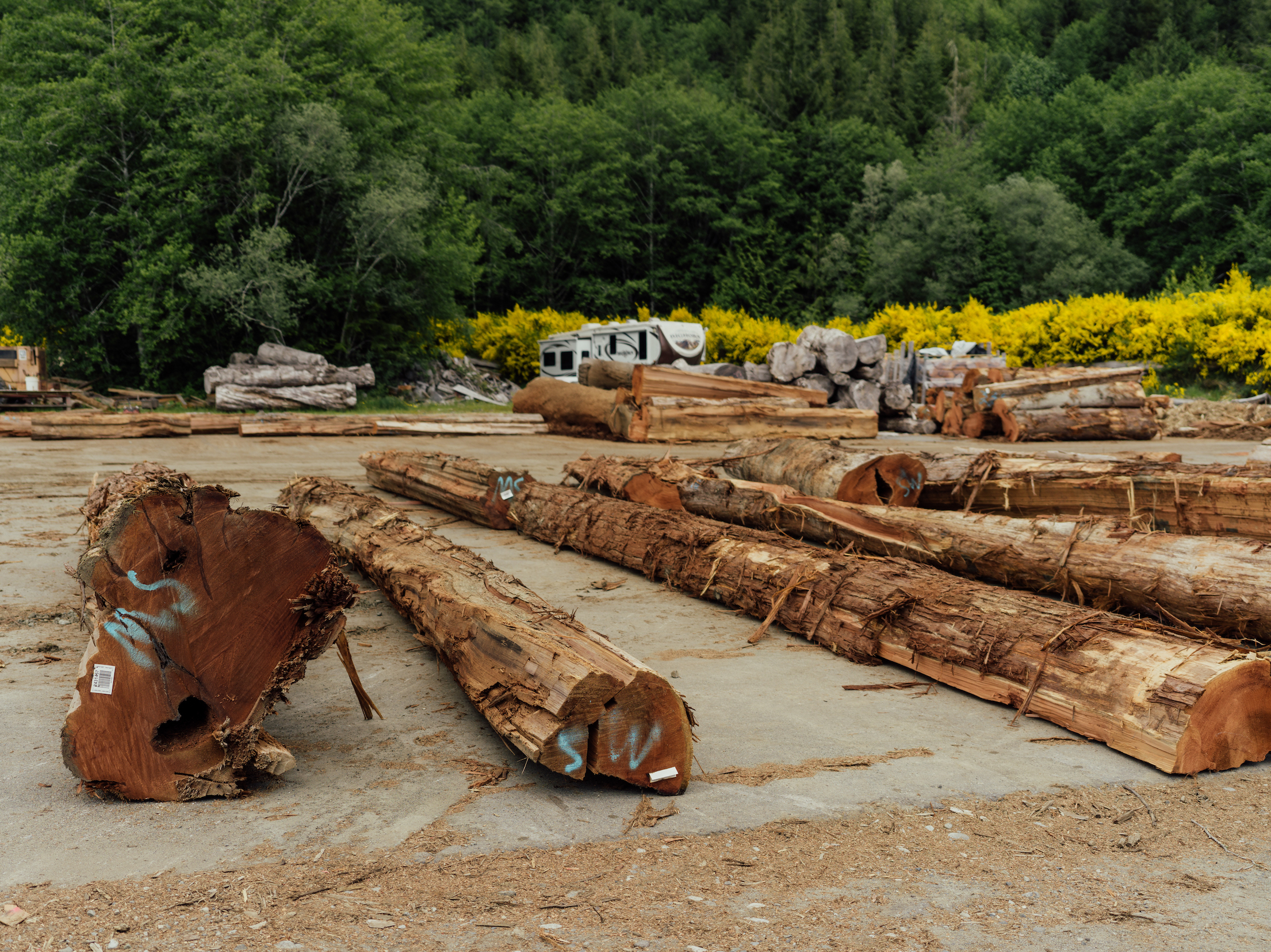


The mill manager requests that his name not be used because of the tensions surrounding the Fairy Creek blockade. He declines to have his photo taken. When curious protesters came to the millyard, he gave them a tour, demonstrating how logs are weighed, washed, bucked and brought to a breakdown saw, where they are cut into slabs. It takes the mill two-and-a-half to three days to cut one logging truck load of cedar. “Old-growth forests are beautiful,” the manager says. “There’s nothing else to it. When you have old-growth cedar you don’t need as much volume. It’s probably worth twice as much. If we were cutting second-growth, we’d be going a lot faster. Cutting old-growth is a slower process. You don’t want to waste it. As little as we get in that bin over there makes me happy.”
He gestures to a small bin with scrap wood from the day’s milling operations, explaining that the mill extracts as much value as possible from every log. Large mills are configured to process uniform logs and produce much more waste, while workers at the Pacheedaht mill examine every log individually, studying where to cut. Milled products go overseas or to the U.S., after they are shipped to another mill that processes the cedar. “They’ll cut these down many more times,” the manager says, pointing to stacks of long lumber. “They’ll take our shorts and they’ll make really high-end cedar blinds, garage doors, window trim. It will get kiln dried after this and the imperfections taken out … the more times it touches Canadian hands the better.” We’ve just missed seeing the polished results of a mill run of salvage wood — logs, black with age and once used for culverts, that were dug up after 60 years buried in the ground.
The mill purchases wood from forestry companies such as Teal Jones and Timber West, as well as from the B.C. government agency BC Timber Sales, which auctions off about 20 per cent of the timber in the province. Logs, including maple and fir, lie in rows and piles in the yard; one orderly row of cedar trunks, perhaps hundreds of years old, has large folds and grooves. The big mills often don’t want those logs, the manager says, because their varying shapes make processing more difficult and expensive. Along the fence sits a huge, smooth cedar trunk that will be used to carve a Pacheedaht canoe this summer, reviving a lapsed tradition with the help of a carver from the Makah Tribe on the Olympic Peninsula of Washington State who, like the Ditidaht, are related to the Pacheedaht.
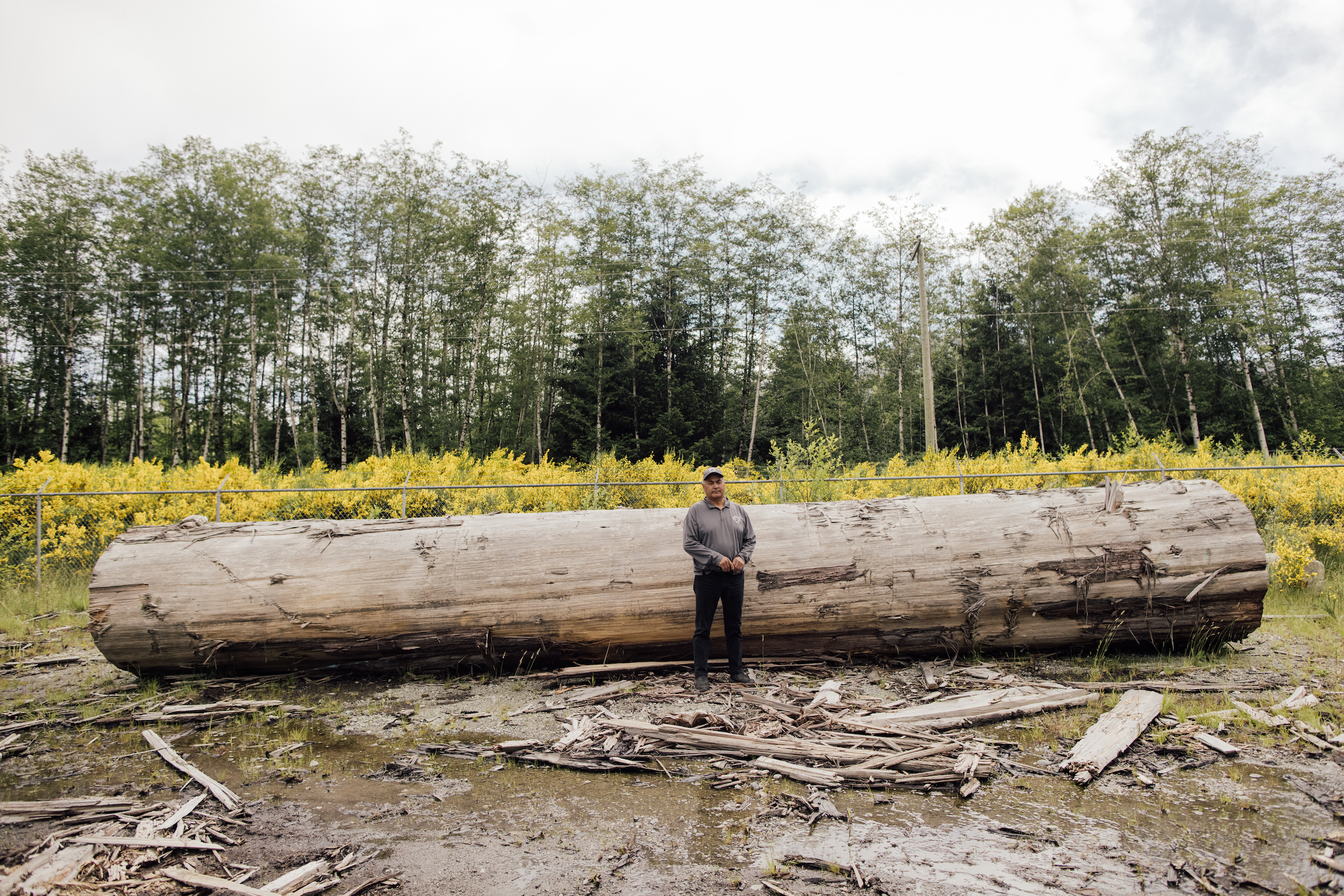
Canoe logs are part of the Pacheedaht cedar conservation strategy, forged in 2005, which identifies the size and volume of cedar the nation requires to revitalize and support its cultural practices. The strategy takes a 400-year view — the time it takes for red cedar to grow to an appropriate size for ocean-going canoes and other cultural items. As it developed the cedar plan, the nation met with all the tree farm licence holders on its territory, also informing the province it wanted to discuss which chunks of land would be set aside for cedar that could be accessed for ceremonial purposes for the next ten generations. “All the TFL holders were really understanding,” the Chief says. “They respected our wishes and they agreed fully.” The Pacheedaht’s cedar strategy includes second-growth, “so we have it for a time when we’re not here.”
In 2017, the Pacheedaht First Nation and B.C. government signed a forest consultation and revenue sharing agreement that gives the Pacheedaht a percentage of stumpage revenues from all timber on its territory cut by tenure holders. The following year, the Pacheedaht First Nation, Cowichan Lake Community Forest Cooperative, the B.C. government and BC Timber Sales reached a new community forest agreement for the Qala:yit Community Forest. That agreement includes an allowable annual cut of 31,500 cubic metres in about 8,000 hectares of scattered parcels of Crown land in TFL 46, including in second growth forest in the lower Fairy Creek watershed.
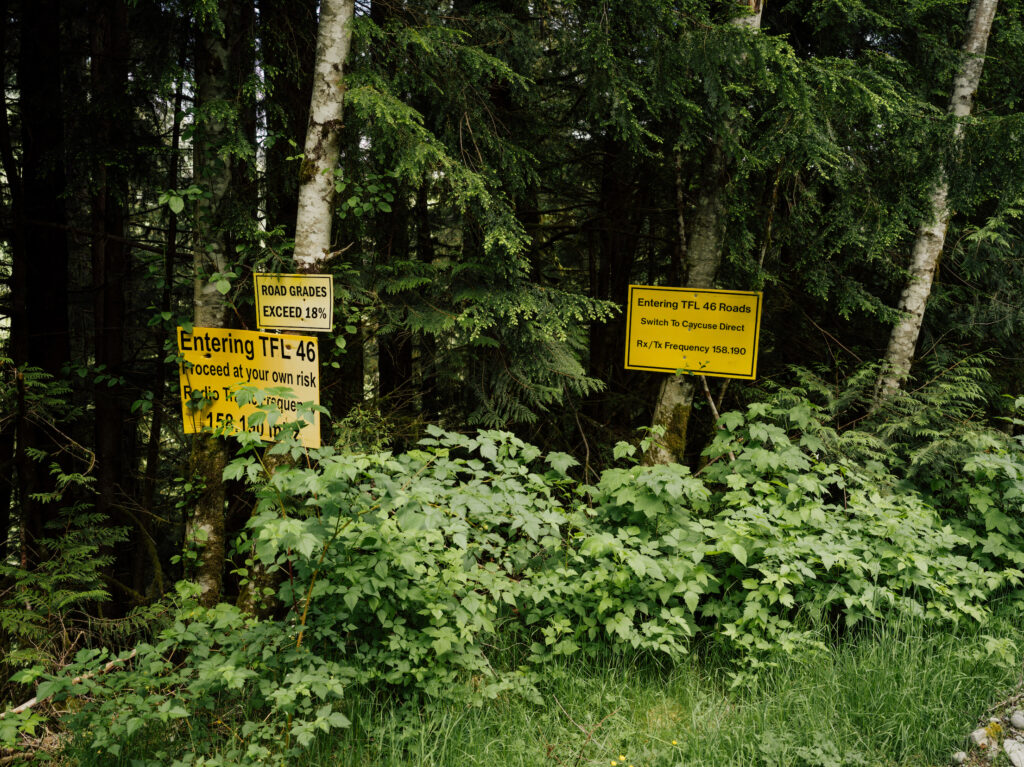
“They’re just starting to gain some economic footing,” Chief Dennis says, “and then — bang — somebody comes along and says ‘oh we don’t want you to be economically viable. We don’t want you to have an economy through old-growth forestry … and, by the way you dumb Indians, you don’t know how to manage your forest, so we’re going to say how to manage it for you.’” Many First Nations involved in the forestry industry, he says, exceed provincial logging and replanting standards.
Revenues from forestry activities have helped Pacheedaht First Nation purchase businesses and fee simple land in its territory, including in and around Jordan River. “We are finding ourselves buying our own land back from private developers, and from either B.C. or the feds,” Chief Jones says. He laughs ruefully. “We feel that’s the only way right now.”
Five years ago, with assistance from forestry revenues, the nation purchased Pacheedaht Mountain, which rises across the San Juan Bay. On a clear day, the mountain is visible from the main reserve. Jones says owning the land outright has heartened band members, who can hold weddings and birthday parties on the mountain, knowing it belongs to the community — unlike the reserve, which lies on federal land. The nation’s long-term plan is to relocate the entire community to the mountain, out of the flood plain and tsunami zone the federal government unilaterally designated for them.
The Pacheedaht community sits on the tip of the finger-shaped Port San Juan, a bay with Botanical Beach Provincial Park at one entry point and a section of the rugged West Coast Trail at the other. Houses and RVs share the landscape with billows of yellow scotch broom and car-sized clumps of blackberry bushes covered in pale pink flowers, invasive species brought to the island by European settlers, along with smallpox and other diseases that decimated a nation once numbering 3,500. The nation has installed water treatment and drainage systems, and it has tapped into an aquifer for potable water.


At the far end of the reserve, near the open ocean and a popular campground run by the Pacheedaht, is the West Coast Trail check in, which the nation runs with Parks Canada. About a half-dozen Pacheedaht members work on the trail, bucking fallen trees, maintaining outhouses and fixing ladders. “It provides a really healthy job for youth,” the Chief says, and a stepping stone for those who move on to Parks Canada positions. Down Pachedah Road, across from an overgrown field, you can get fish and chips take-out at the “Don’t Pannock, We Got Bannock” stand run by a Pacheedaht member who is a chef and one of the nation’s cedar experts. The murmur of crashing surf follows us everywhere, and salt dusts our lips and skin.
From Port Renfrew, we follow the Chief up a steep gravel road to Soule Creek Lodge, which the nation purchased in 2019 with revenues from forestry. Perched on the Juan de Fuca ridge, with panoramic views of Olympic Peninsula, the Coast Mountains and the Juan de Fuca Strait, the lodge and its 160-hectare grounds, which include gardens and a hot tub, offer accommodation in seven yurts, a cabin and four suites in the main building.


The cabin and some of the yurts overlook the San Juan inlet, where gray whales sometimes rub their bellies on stones. During the low-season, the Pacheedaht use the lodge for training sessions for members who are earning or renewing certifications in everything from first aid to marine radio operation.
Outside the main lodge we run into Lenore Jones, an infant-child educator at the Pacheedaht pre-school who is working at the lodge for the summer. Jones, who grew up in Nanaimo, visiting the reserve several times a year, says she is happy to see her community growing.
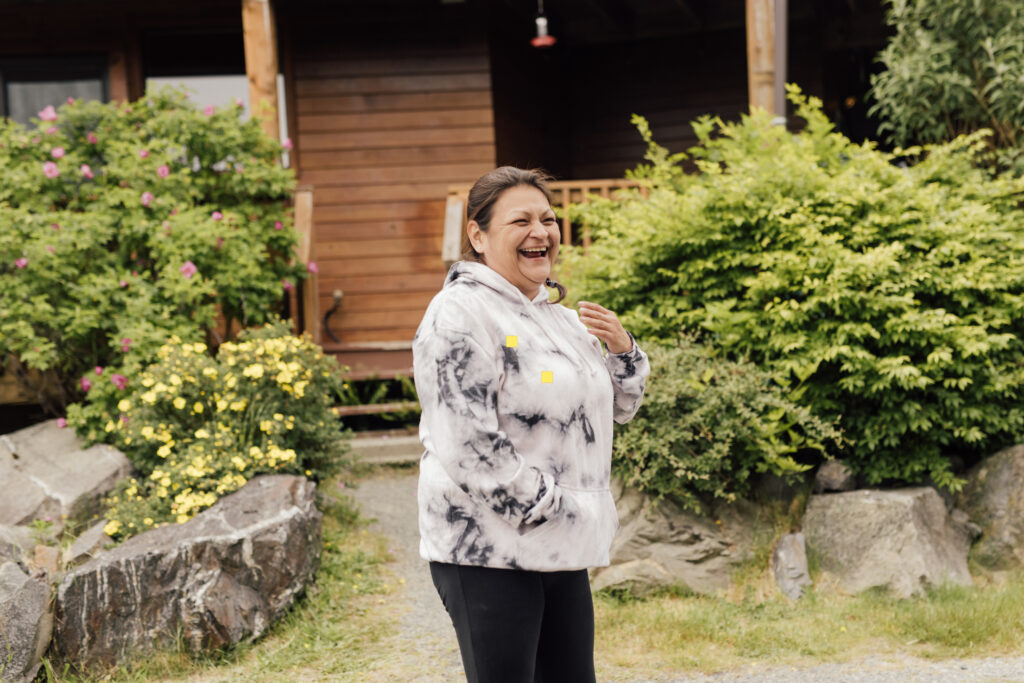


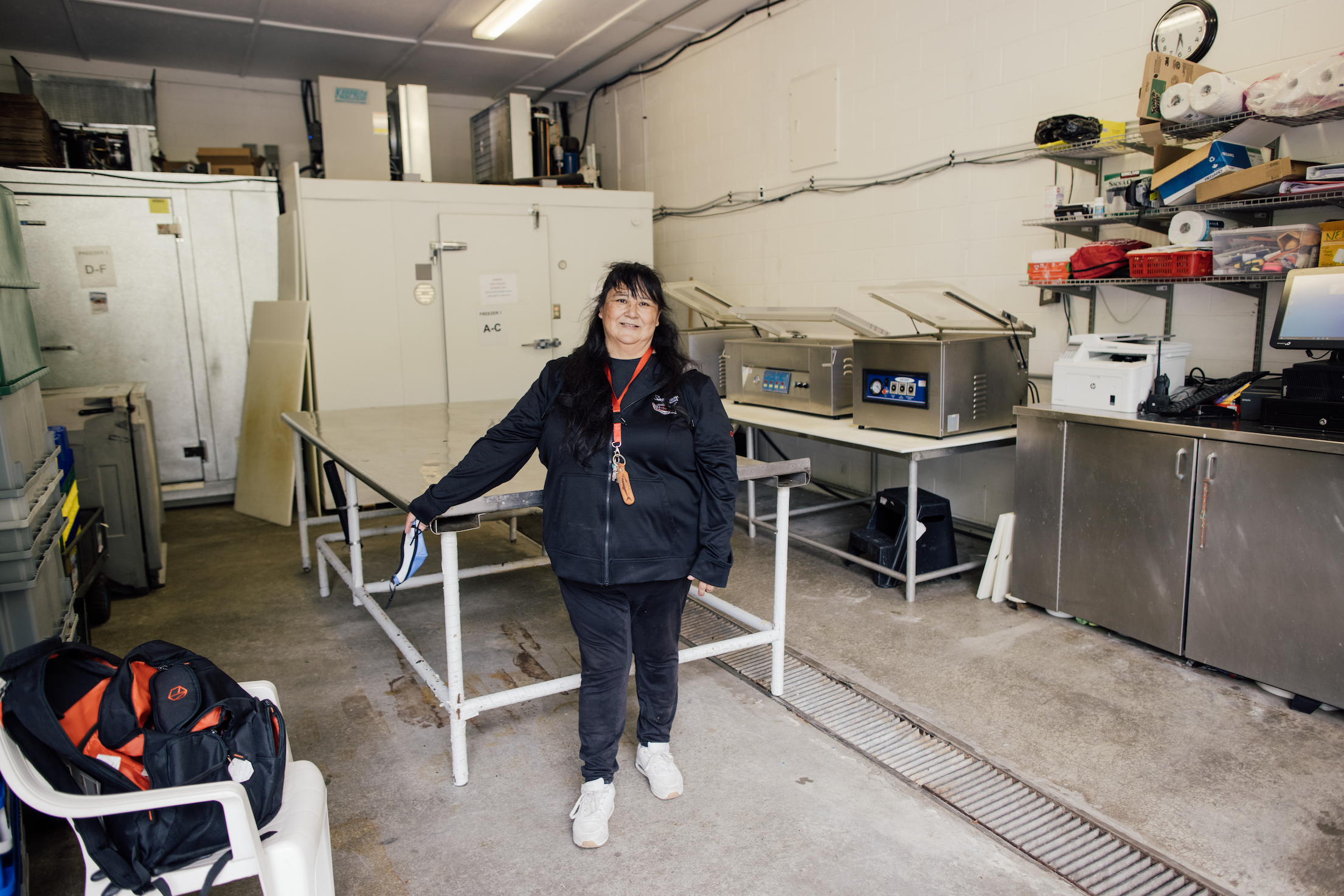
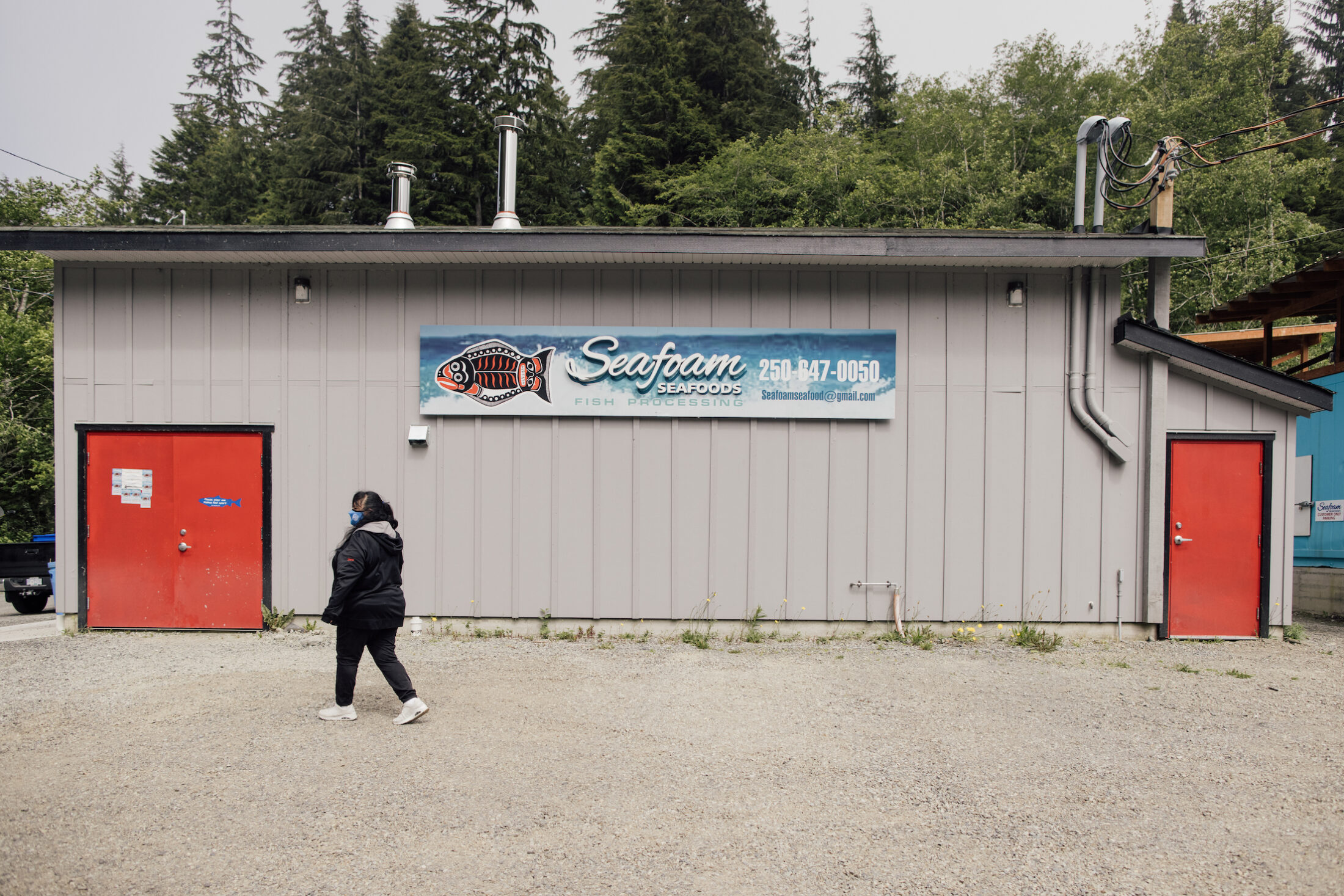
A grant unrelated to forestry allowed the nation to buy a fish processing enterprise in Port Renfrew called Seafoam Seafoods, where sports fishers take their catch. “Halibut, salmon, rockfish, lingcod — they bring it in and we weigh it and vacuum pack,” says Seafoam manager Diane Point, a Pacheedaht member who returned to the community from the Lower Mainland, where she worked at the Steveston Fish Auction. Smoking your catch will also soon be an option; the Pacheedaht have purchased an industrial smoker from Germany. During the busy summer tourist season, when eight to 12 people are employed full and part-time at Seafoam, the nation also has a stand on the site that sells live and cooked crab.
Jones says the nation, which now has 170 employees across all of its ventures, can offer employment to any member who wants it. As Pacheedaht members move back from other communities, the nation is building houses for community members and returnees like Point. Housing is a priority, the Chief says. But uppermost on his mind, with the end of the school year fast approaching, is that Pacheedaht youth have to travel three hours and 20 minutes each weekday by bus to get back and forth to school. “It’s really long days from Grade 6 to 12 to try to get them to the point that they graduate,” Jones says. “It’s very challenging. It’s very hard on the body. Our nation is trying to find ways to build our own K to 12, but it’s going to take a little longer than we thought.”
That evening, after the Chief leaves to prepare for a trip to the Ditidaht First Nation the next day, we drive past the saw mill and up a logging road flanked by a recent clear cut. Our destination is a Flying Rainforest Squad camp known as Brayden or Hayhaka, not far from Avatar Grove, a big-tree forest protected by the B.C. government in 2012 after the Ancient Forest Alliance drew public attention to plans for its imminent logging. Cars are parked up and down the logging road. People mill about. I roll down the window and ask a woman with long auburn hair and a baseball cap what’s going on. “We’ve just been raided,” she says. “We’re rebuilding the camp.”
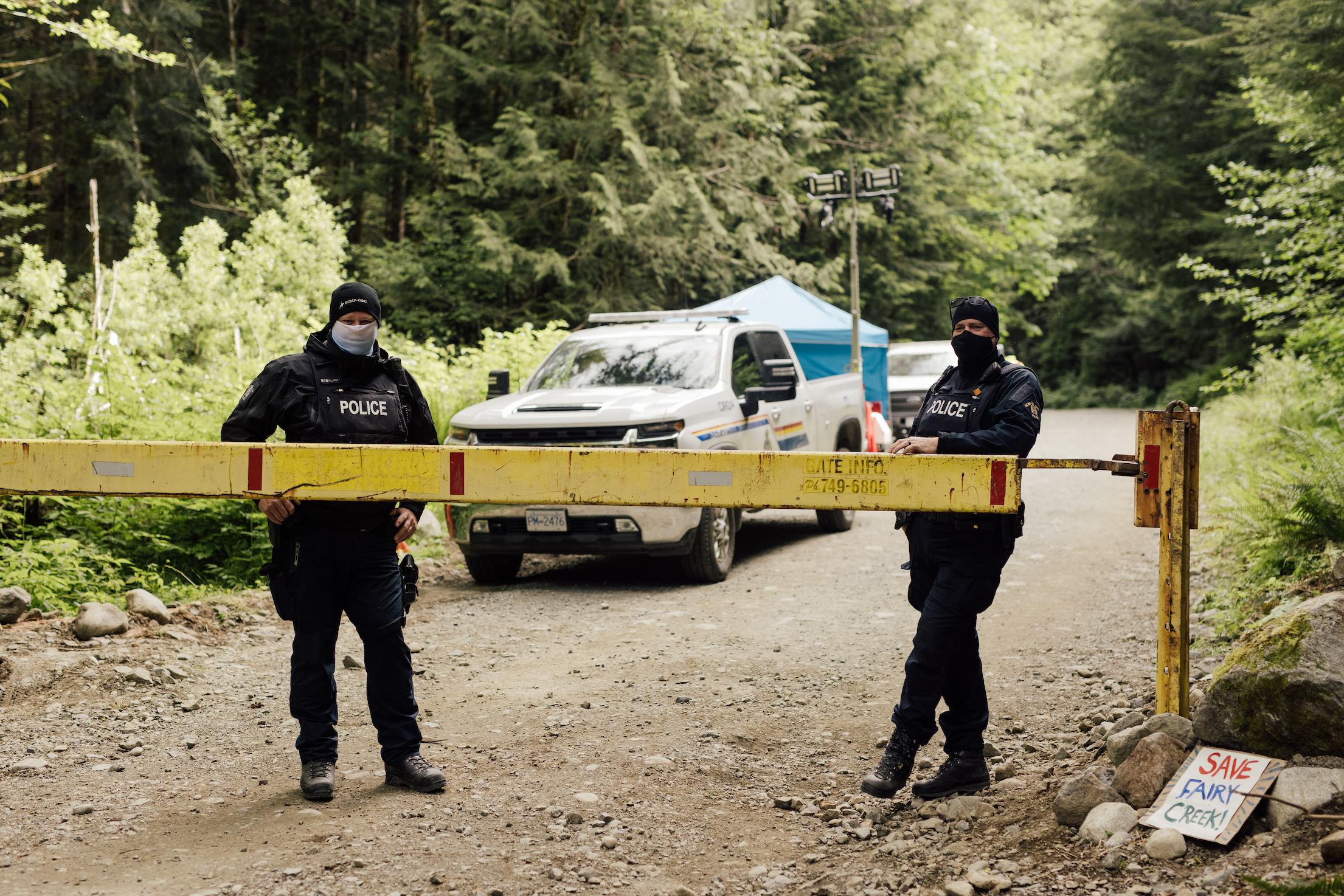
Vehicles are parked along the road; small tents tuck into the forest. Up ahead, people gather around a campfire near protective tarps. “Last Stand Hayhaka,” proclaims a white banner strung across the road. A friendly woman in track pants reads us a media statement: “We are on unceded Pacheedaht and Ditidaht territory. We are here as guests. We have been invited by Elder Bill Jones and Victor Peter and we are standing here as land defenders and forest protectors in solidarity with the Indigenous folks I just named. That’s all I can say.”
Earlier that day, RCMP had arrested a handful of people at the camp, which blocked the road to higher elevation camps known as Ridge and Waterfall. When the RCMP left, campers who hadn’t been arrested moved back in, joined by reinforcements who drove in after the RMCP road blockade was removed. “We can’t have pictures of people with masks off,” the woman instructs us. “We can’t have pictures of licence plates and we can’t have pictures of infrastructure, so I would say this is not something you can take a picture of. I would go to HQ and get information.”
Less than 20 minutes later, we pull off Pacific Marine Road at the Fairy Creek blockade headquarters. We’re greeted by a middle-aged man with a clipboard, who stands near the headquarter’s curiously named “misinformation table.” He seems perturbed that we haven’t told anyone we were coming, even though there’s no cell reception anywhere in the area and only a general form on the Flying Rainforest Squad website. (When The Narwhal sent a message later, asking for comment about social media posts, we didn’t receive a response.) “What would you have said if you’d emailed?” he asks us. Eventually he waves us into the gravel pit, which looks almost post-apocalyptic, with tents and camp stoves set up amidst heaps of gravel and vehicles. We head up to the media tent for an orientation. There’s a new camp called Helicopter, we’re told. The RCMP landed a helicopter there. When it took off, the protesters moved in.
The next morning, plainclothes RCMP officers wearing backpacks steal into Waterfall camp before dawn. They spray foam in the sleeping dragons so protesters can’t insert their arms. We eschew the daily RCMP media escort and try to make our own way in, even though the RCMP has told us we might not be able to get access to injunction enforcement areas on our own. (The Narwhal is part of a coalition of Canadian news organizations and press freedom groups that has launched a legal action requesting the media be allowed fair access to the demonstrations and arrests and expressing deep concern about serious violations of press freedoms.)
On the other side of the Hayhaka camp, a yellow metal beam, guarded by two tall RCMP officers from Parksville and Gold River, blocks access to Ridge and Waterfall camps. The officers are waiting for their breakfast to be delivered, hoping it might still be warm. They review our credentials, take down our birth dates and turn away to radio the RCMP media liaison to see if they can lift the forestry road gate for us. A few minutes later, they return with the news that they can’t leave their post and there is no one available to escort us. We can’t drive up alone, they say, but we’re free to walk about eight kilometres one way to Ridge camp. They seem relieved, because the gate is difficult to open; they have to bash one end with rocks before it will lift.
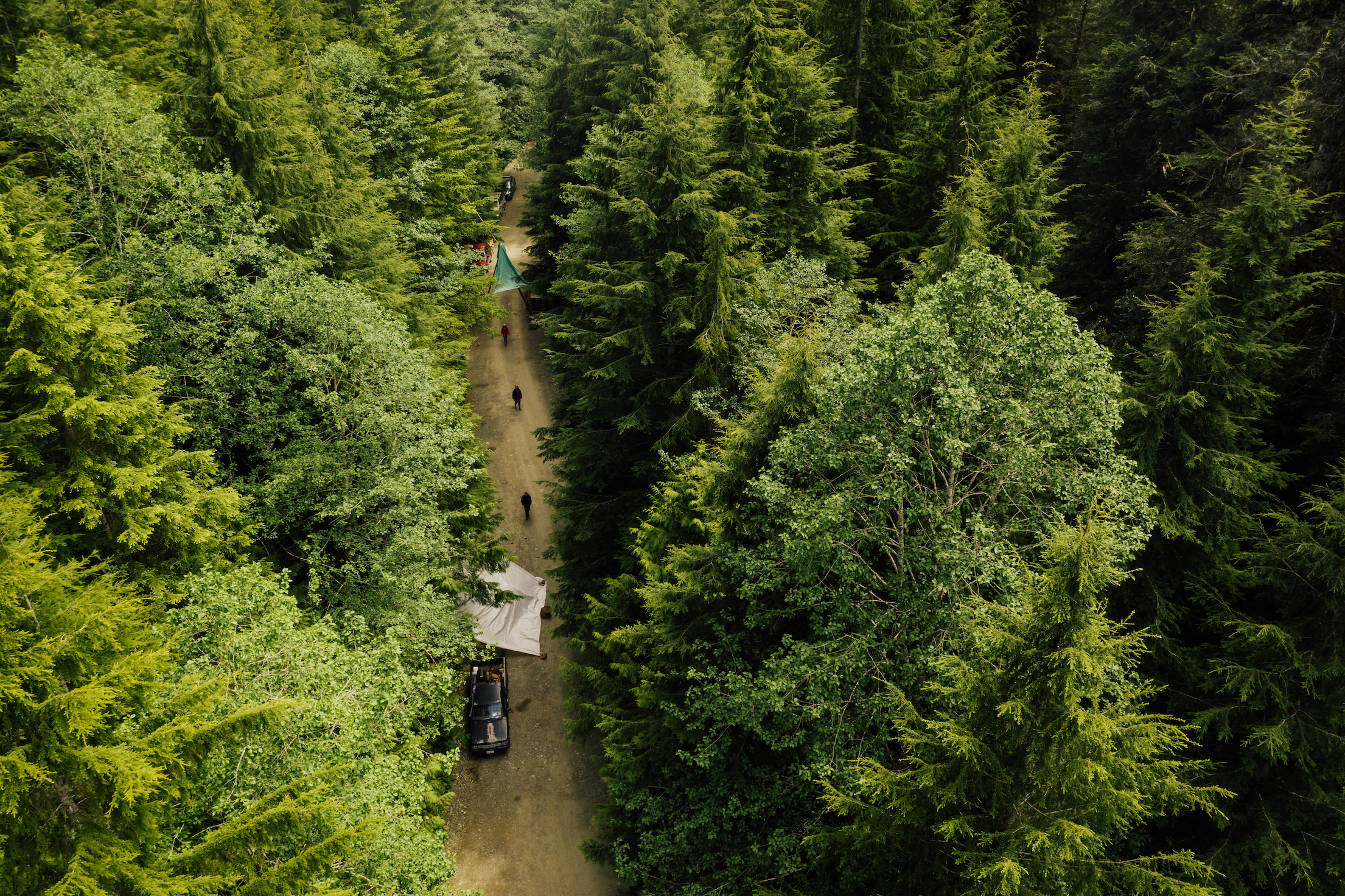
At the blockade headquarters, the campers give us permission to drive five or six kilometres up a logging road, surrounded by clear cuts, to River camp, named for Renfrew Creek that burbles below. River camp, in the heavily logged drainage adjacent to Fairy Creek, has a well-equipped, roofed kitchen where we meet a barefoot man who calls himself Bootz (“Bootz with a z,” he makes clear.) He’s not the camp cook, he says, but more of a culinary artist. The camp is just metres away from two enormous cedar trees the protesters have named Grandfather tree and Grandmother tree.
Next to the camp is the ribbon-flagged trailhead to a one-kilometre walk through a magical, mossy old-growth forest, with tall huckleberry and salal bushes. It smells of fresh cedar. A new boardwalk has been expertly built with wood from a giant cedar tree that toppled in an April storm. I ask a young woman called “Firefly,” who shows us the trailhead, if the remaining old-growth around the camp is slated for logging. “It’s all going to be logged,” she says. (While there’s one area designated for logging near River camp, there’s also a sliver of an old-growth management area along the creek near the camp.)
While we explore the area around River camp, Chief Jones and Chief Dennis are in Ditidaht territory, signing a declaration with Ditidaht Chief Brian Tate. The Hišuk ma c̕awak Declaration states that the three nations are taking back their power over their ḥahahuułi (traditional territories), after more than 150 years on the sidelines while others decided what was best for their lands, water and people.
“This declaration brings this practice to an immediate end,” the nations say, underscoring that decisions about monumental cedar protection and forest management must be led by the people who hold rights and title and who have looked after the land for thousands of years.
“Third parties — whether they are companies, organizations, other governments or individuals — have no right to speak on behalf of the Nations,” the nations make clear. “Moreover, for third parties to be welcome in their ḥahahuułi, they must respect their governance and stewardship, sacred principles, and right to economically benefit from the resources within the ḥahahuułi.”
After we leave the Pacheedaht sawmill, Chief Jones stops by the side of the road to show us a sign describing the fisheries restoration project. We chat over a chorus of birdsong, as a succession of vehicles drives by: tourists trickling back to Port Renfrew as COVID-19 pandemic restrictions ease, unmarked white trucks carrying RCMP officers in uniform back from the Hayhaka camp, cars filled with people returning home after a day at the blockades.
“Forestry is and will always be part of Pacheedaht Nation,” the Chief tells us. “We’re not going to leave. We’re not leaving as a nation. We’re always going to be here, present. We’ve been here for many, many thousands of years and we’re not going anywhere. I want to make that clear to the world. Nations do not move.”
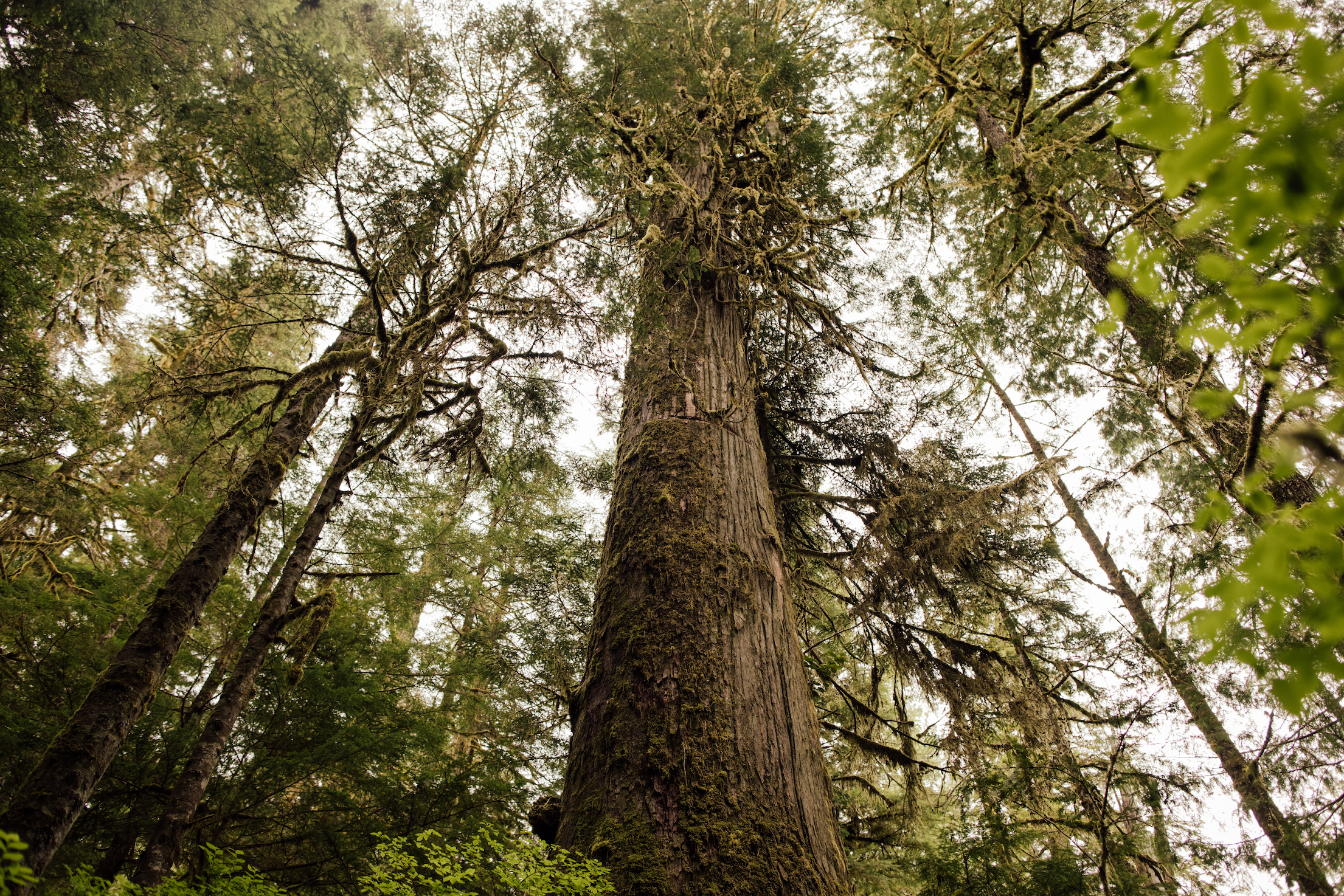
Karyn Pugliese, aka Pabàmàdiz, was a contributing editor on this article. Pugliese ran the news department at APTN for seven years before joining Ryerson University as an assistant professor of journalism in the spring of 2020. She is a citizen of the Pikwàkanagàn First Nation in Ontario, and is of mixed Algonquin and Italian descent.
Get the inside scoop on The Narwhal’s environment and climate reporting by signing up for our free newsletter. On a warm September evening nearly 15...
Continue reading
10 billion litres of sewage are dumped into Winnipeg’s lakes and rivers each year. Some...

Court sides with Xatśūll First Nation, temporarily halting Mount Polley mine waste expansion

Break out the champagne: Emma’s storied life and leadership in journalism has earned her the...
